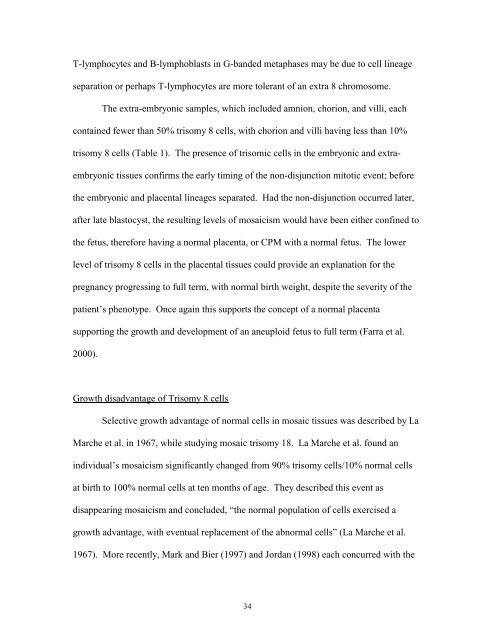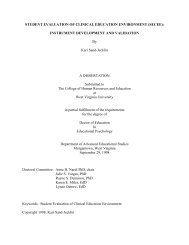TRISOMY 8 MOSAICISM: CELL CYCLE KINETICS AND ...
TRISOMY 8 MOSAICISM: CELL CYCLE KINETICS AND ...
TRISOMY 8 MOSAICISM: CELL CYCLE KINETICS AND ...
You also want an ePaper? Increase the reach of your titles
YUMPU automatically turns print PDFs into web optimized ePapers that Google loves.
T-lymphocytes and B-lymphoblasts in G-banded metaphases may be due to cell lineage<br />
separation or perhaps T-lymphocytes are more tolerant of an extra 8 chromosome.<br />
The extra-embryonic samples, which included amnion, chorion, and villi, each<br />
contained fewer than 50% trisomy 8 cells, with chorion and villi having less than 10%<br />
trisomy 8 cells (Table 1). The presence of trisomic cells in the embryonic and extra-<br />
embryonic tissues confirms the early timing of the non-disjunction mitotic event; before<br />
the embryonic and placental lineages separated. Had the non-disjunction occurred later,<br />
after late blastocyst, the resulting levels of mosaicism would have been either confined to<br />
the fetus, therefore having a normal placenta, or CPM with a normal fetus. The lower<br />
level of trisomy 8 cells in the placental tissues could provide an explanation for the<br />
pregnancy progressing to full term, with normal birth weight, despite the severity of the<br />
patient’s phenotype. Once again this supports the concept of a normal placenta<br />
supporting the growth and development of an aneuploid fetus to full term (Farra et al.<br />
2000).<br />
Growth disadvantage of Trisomy 8 cells<br />
Selective growth advantage of normal cells in mosaic tissues was described by La<br />
Marche et al. in 1967, while studying mosaic trisomy 18. La Marche et al. found an<br />
individual’s mosaicism significantly changed from 90% trisomy cells/10% normal cells<br />
at birth to 100% normal cells at ten months of age. They described this event as<br />
disappearing mosaicism and concluded, “the normal population of cells exercised a<br />
growth advantage, with eventual replacement of the abnormal cells” (La Marche et al.<br />
1967). More recently, Mark and Bier (1997) and Jordan (1998) each concurred with the<br />
34












